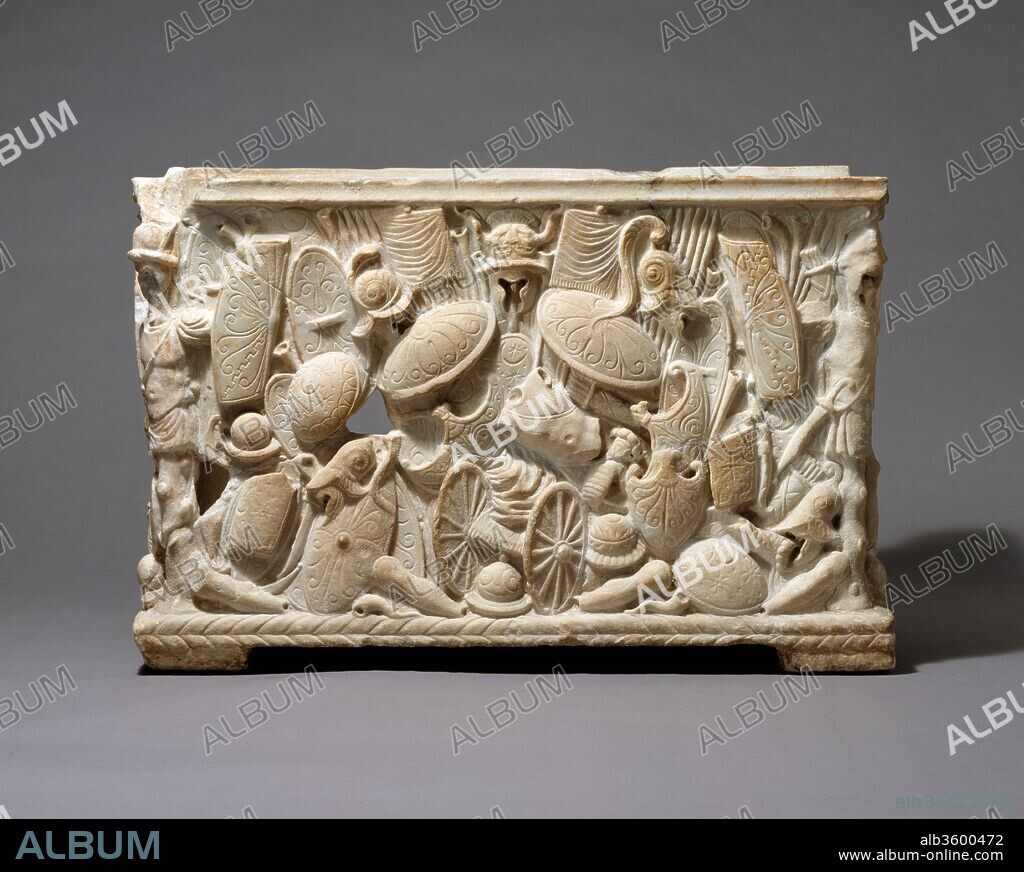alb3600472
Marble cinerary urn

|
Zu einem anderen Lightbox hinzufügen |
|
Zu einem anderen Lightbox hinzufügen |



Haben Sie bereits ein Konto? Anmelden
Sie haben kein Konto? Registrieren
Dieses Bild kaufen.
Nutzung auswählen:

Titel:
Marble cinerary urn
Untertitel:
Automatische Übersetzung: Aschenurne aus Marmor. Kultur: Roman. Abmessungen: Insgesamt: 14 1/4 x 21 1/4 x 16 1/8 in. (36,2 x 54 x 41 cm). Datum: 1. Hälfte des 1. Jahrhunderts n. Chr. Diese römische Aschenurne ist höchst ungewöhnlich, da sie die Kriegsbeute als Hauptthema hat. Trotz der fragmentarischen Natur des Stücks sind die Trophäen und Waffen- und Rüstungsstapel, die die Rückseite und die Seiten der geradlinigen Kiste bedecken, sehr auffällig. Sowohl im Detail als auch in der Komposition sind die Tafeln repräsentativ für eine hochwertige Verarbeitung, was darauf hindeutet, dass es sich bei der Arbeit um einen Sonderauftrag handelte. Leider fehlt ein Großteil der Vorderseite, wo die Inschrift mit dem Namen des Verstorbenen gewesen wäre. Die Urne soll 1899 aus einem Grab in der Nähe von Anagni, südöstlich von Rom, ausgegraben worden sein. Andere Marmorurnen in der Sammlung des Museums (siehe 96.9.222a, b; 25.78.29; und 27.122.2a, b; ausgestellt im Hof) gehören zu den viel häufigeren Formen der römischen Grabkunst, Aschenurnen, die entweder echten Gefäßen (Vasen oder Körben) ähneln oder die Form von Altären oder Miniaturgebäuden haben. Sowohl in der Ikonographie als auch in der Handwerkskunst weist die vorliegende Urne auf die kunstvollen Sarkophage der mittleren Kaiserzeit hin.
Marble cinerary urn. Culture: Roman. Dimensions: Overall: 14 1/4 x 21 1/4 x 16 1/8 in. (36.2 x 54 x 41 cm). Date: 1st half of 1st century A.D..
This Roman cinerary urn is highly unusual in having the spoils of war as its principal theme. Despite the fragmentary nature of the piece, the trophies and piles of weapons and armor that cover the back and sides of the rectilinear box are very striking. In both detail and composition, the panels are representative of high-quality workmanship, suggesting that the work was a special commission. Sadly, much of the front, where the inscription recording the name of the deceased would have been, is missing. The urn is said to have been excavated from a tomb near Anagni, southeast of Rome, in 1899.
Other marble funerary urns in the Museum's collection (see 96.9.222a, b; 25.78.29; and 27.122.2a, b; on display in the courtyard) belong to much more common types of Roman funerary art, cinerary urns that either resemble actual receptacles (vases or baskets) or are in the form of altars or miniature buildings. In both iconography and craftsmanship, the present urn foreshadows the elaborate sarcophagi of the Mid-Imperial period.
Technik/Material:
MARMOL
Zeitraum:
Early Imperial, Julio-Claudian
Museum:
Metropolitan Museum of Art, New York, USA
Standort:
ROMAN EMPIRE
Bildnachweis:
Album / Metropolitan Museum of Art, NY
Freigaben (Releases):
Model: Nein - Eigentum: Nein
Rechtefragen?
Rechtefragen?
Bildgröße:
4200 x 3360 px | 40.4 MB
Druckgröße:
35.6 x 28.4 cm | 14.0 x 11.2 in (300 dpi)
Schlüsselwörter:
 Pinterest
Pinterest Twitter
Twitter Facebook
Facebook Link kopieren
Link kopieren Email
Email
